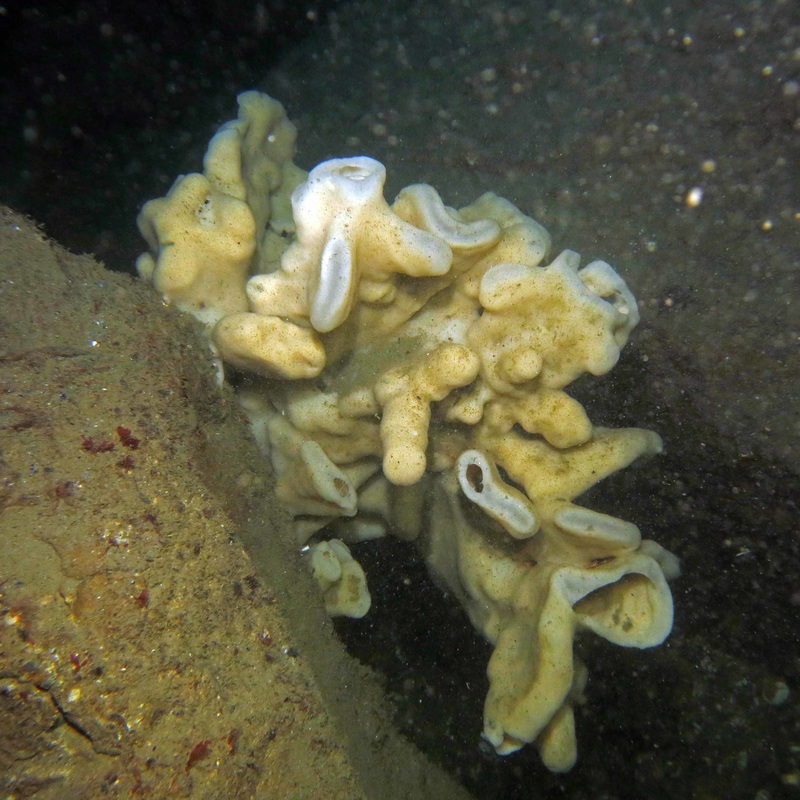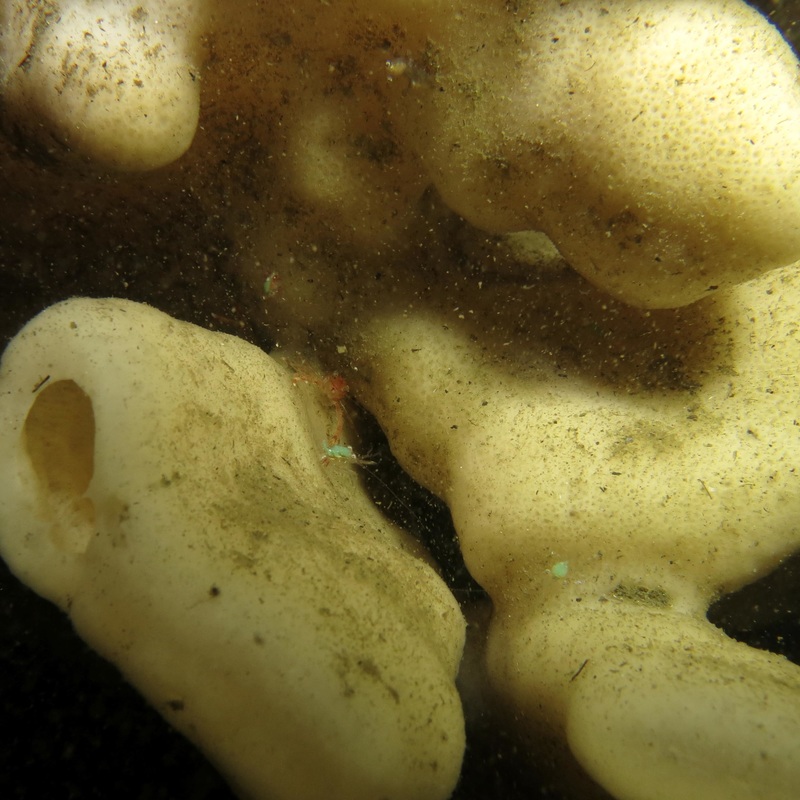Cloud sponge, clay pipe sponge • Aphrocallistes vastus
Identification
This large hexactinellid sponge grows in cloud-like formations and has a texture similar to styrofoam, with an underlying rigid structure. It grows to 3 m tall or across, and is whitish or yellowish in colour. The end branches of the sponge may be tube- or palm-shaped.
Habitat & Range
The cloud sponge grows in the subtidal from 10 to 1600 m deep. Its range extends from northern Mexico north to northern Alaska, and across the Bering Sea to Siberia. It has also been reported in coastal Japan.
Similar Species
The fingered goblet sponge (Heterochone calyx) has a similar cloud-like shape and a styrofoam texture; The walls of this sponge are thicker than those of the cloud sponge, and it often is flared out at the top, like a vase.
Intriguing Info
The cloud sponge provides shelter for many organisms at varying life stages, including the sponge eualid (Eualus butleri), the golden king crab (juveniles), and the bigmouth sculpin (eggs). It is preyed upon by
Due to its rigid 'scaffolding', the cloud sponge—along with the fingered goblet sponge—plays a key structural role in the glass sponge reefs found along the BC coastline. Learn more about the glass sponge reefs on the Canadian Parks and Wilderness Society BC and Living Oceans websites.
iNaturalist
https://www.inaturalist.org/taxa/424651-Aphrocallistes-vastus
This large hexactinellid sponge grows in cloud-like formations and has a texture similar to styrofoam, with an underlying rigid structure. It grows to 3 m tall or across, and is whitish or yellowish in colour. The end branches of the sponge may be tube- or palm-shaped.
Habitat & Range
The cloud sponge grows in the subtidal from 10 to 1600 m deep. Its range extends from northern Mexico north to northern Alaska, and across the Bering Sea to Siberia. It has also been reported in coastal Japan.
Similar Species
The fingered goblet sponge (Heterochone calyx) has a similar cloud-like shape and a styrofoam texture; The walls of this sponge are thicker than those of the cloud sponge, and it often is flared out at the top, like a vase.
Intriguing Info
The cloud sponge provides shelter for many organisms at varying life stages, including the sponge eualid (Eualus butleri), the golden king crab (juveniles), and the bigmouth sculpin (eggs). It is preyed upon by
Due to its rigid 'scaffolding', the cloud sponge—along with the fingered goblet sponge—plays a key structural role in the glass sponge reefs found along the BC coastline. Learn more about the glass sponge reefs on the Canadian Parks and Wilderness Society BC and Living Oceans websites.
iNaturalist
https://www.inaturalist.org/taxa/424651-Aphrocallistes-vastus
References
Corrigan, B. Aphrocallistes vastus Cloud Sponge. Encyclopedia of Life. Accessed 19/11/2015.
Lamb, A., and Hanby, B. (2005). Marine Life of the Pacific Northwest [electronic version]. Madeira Park, BC: Harbour Publishing.
van Soest, R. (2008). Aphrocallistes vastus Schulze, 1886. World Register of Marine Species. Accessed 19/11/2015.
Authors and editors of page
Kelly Fretwell (2015).
Corrigan, B. Aphrocallistes vastus Cloud Sponge. Encyclopedia of Life. Accessed 19/11/2015.
Lamb, A., and Hanby, B. (2005). Marine Life of the Pacific Northwest [electronic version]. Madeira Park, BC: Harbour Publishing.
van Soest, R. (2008). Aphrocallistes vastus Schulze, 1886. World Register of Marine Species. Accessed 19/11/2015.
Authors and editors of page
Kelly Fretwell (2015).






